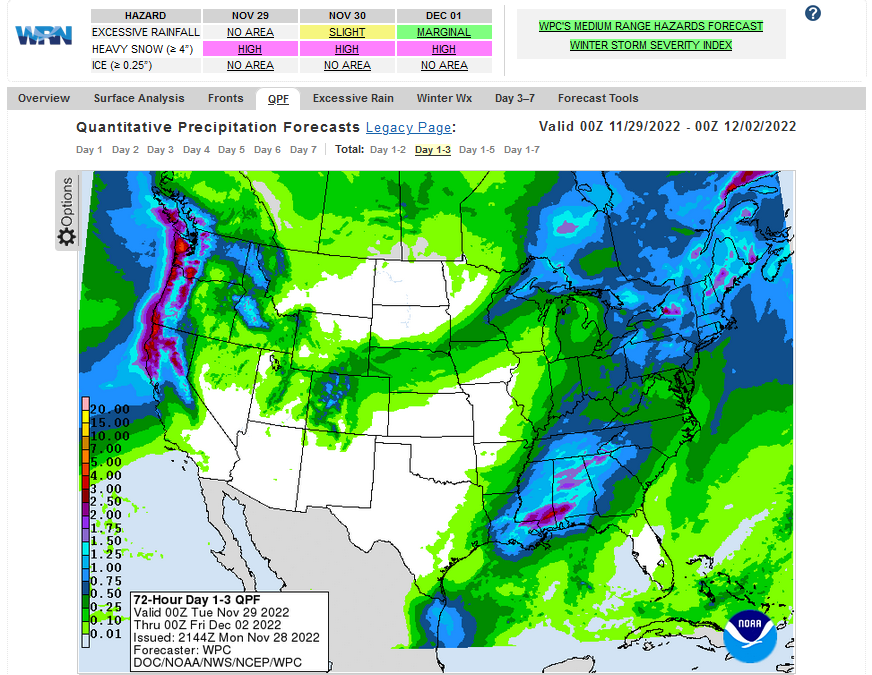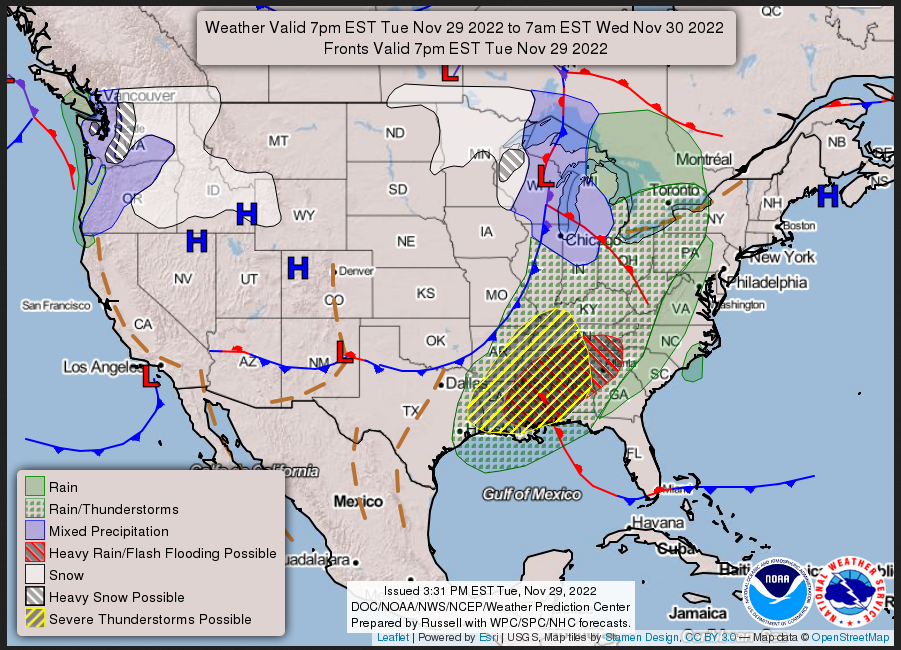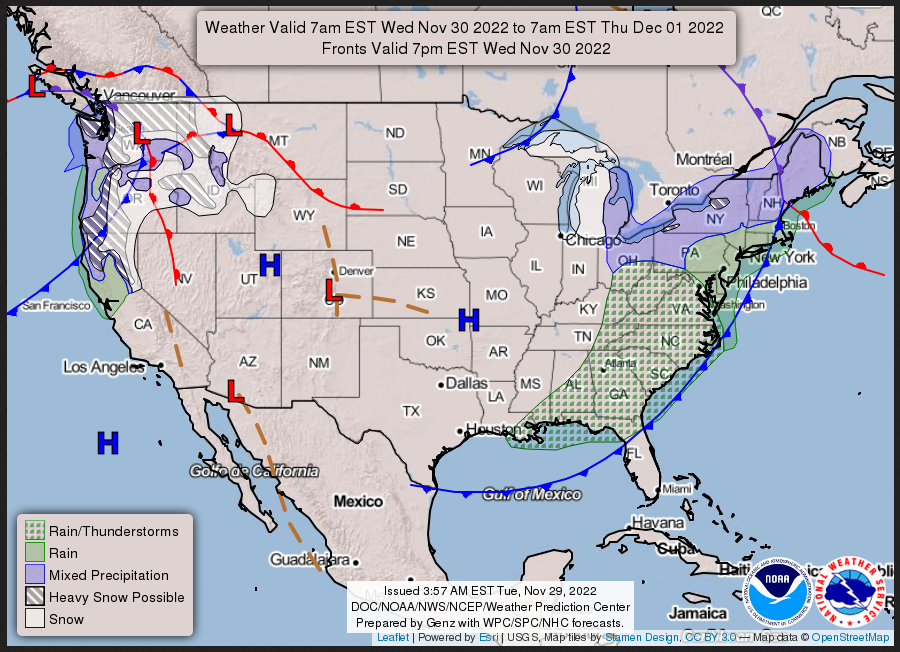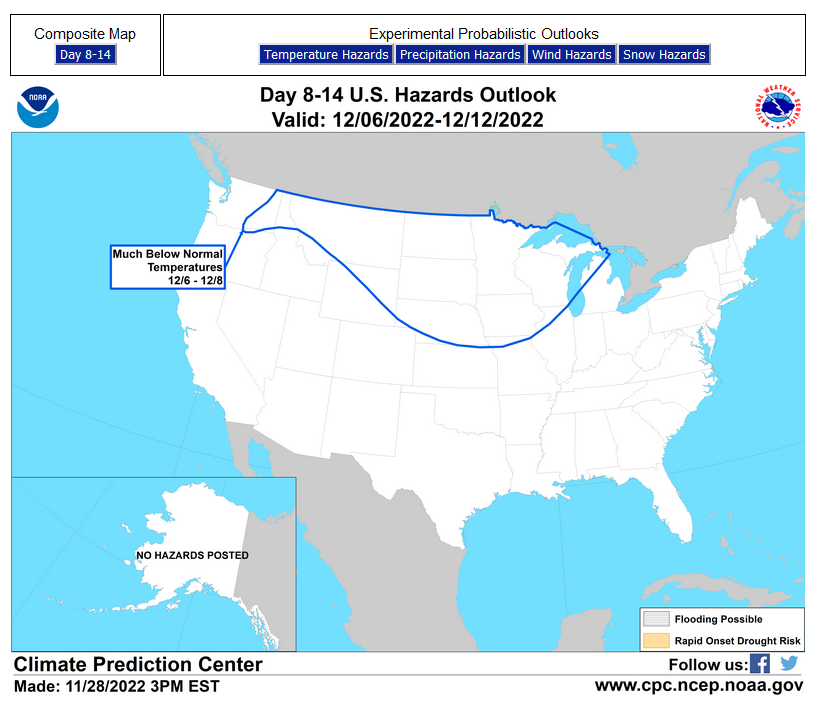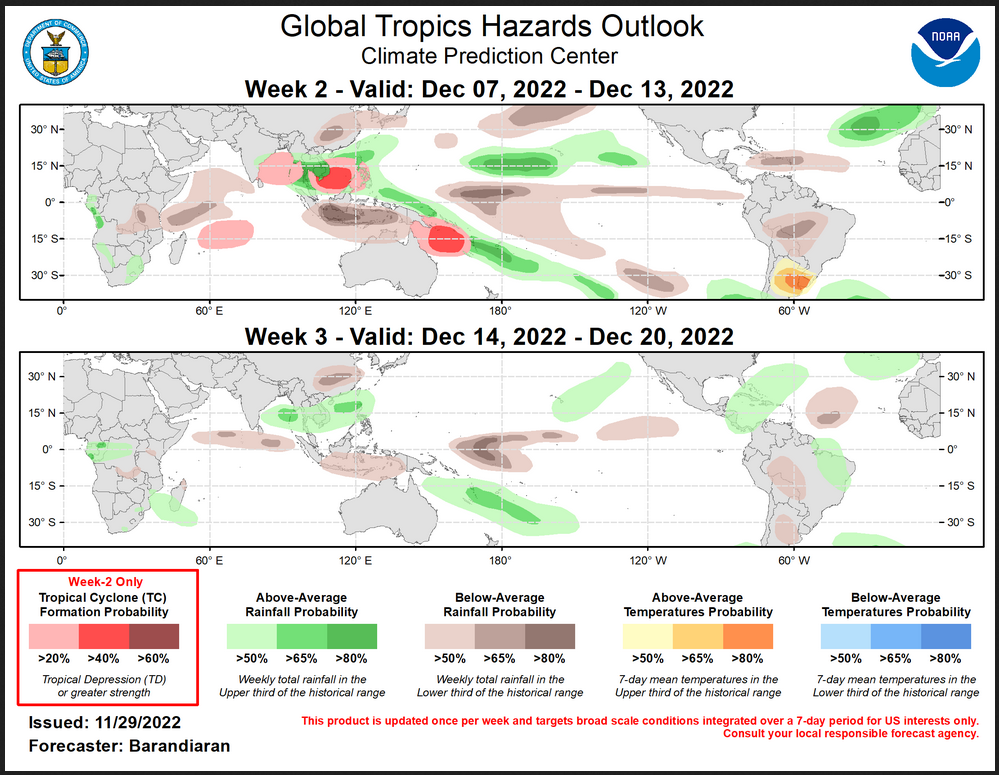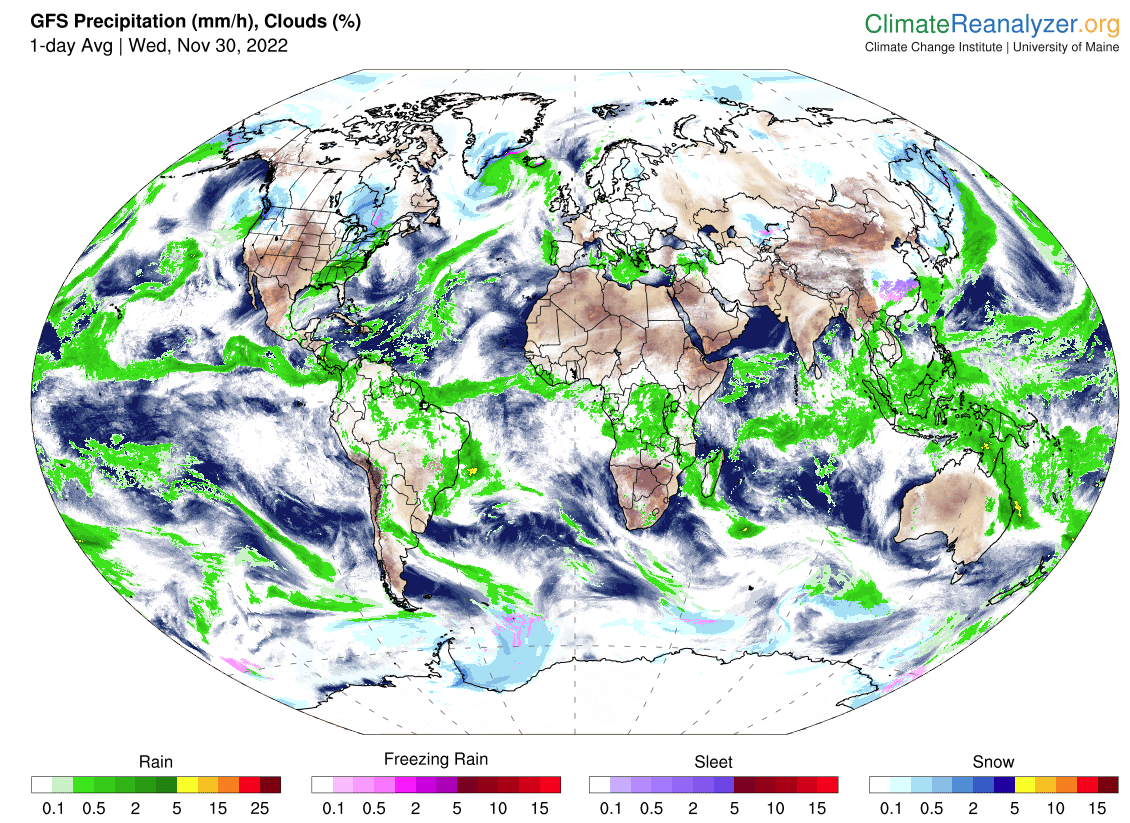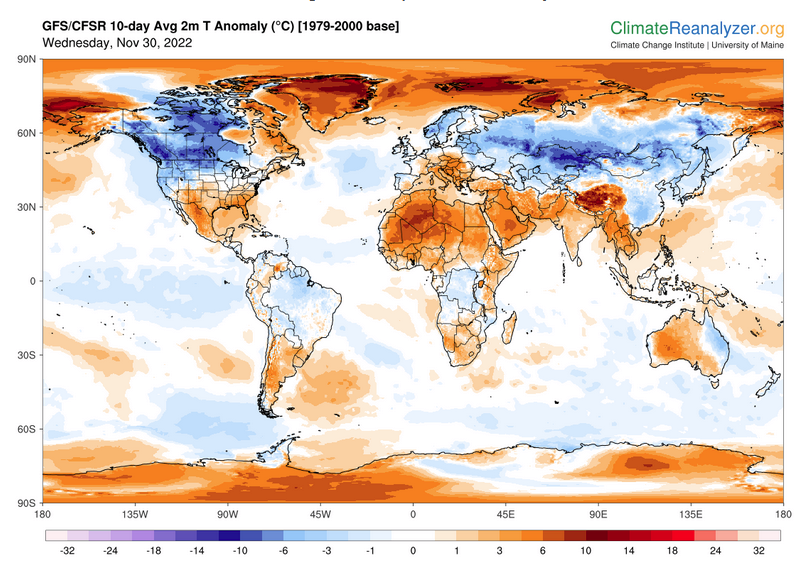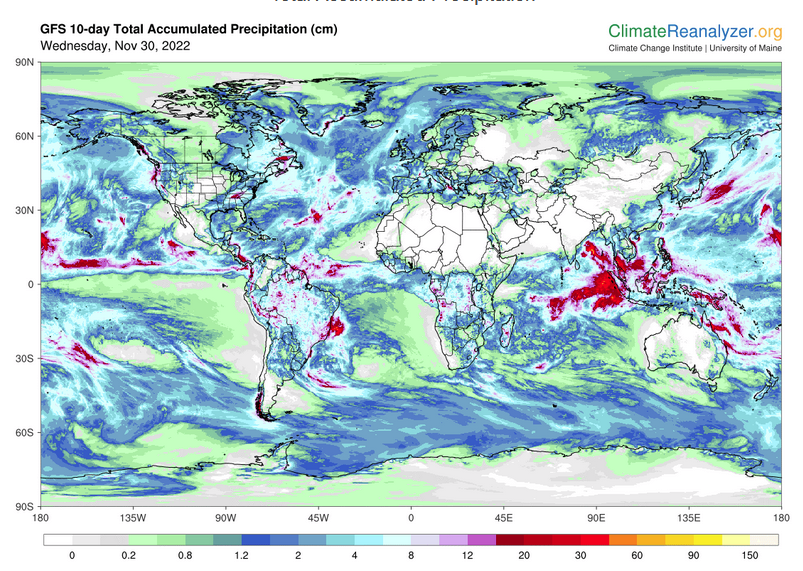Updated on Tuesday November 29, 2022
Here is what we are paying attention to tonight and the next 48 hours from Tuesday Afternoon’s NWS Forecast.
...Heavy snow for the Cascades, Sierra and Northern Rockies... ...There are moderate flash flooding and severe weather threats over portions of the Lower Mississippi & Tennessee Valleys and Southeast tonight...
Continuation of the NWS Short Range Forecast (It is updated by NWS twice a day and these updates can be found here. We post at least one of those updates daily, sometimes both.
An upper-level trough will move across the Midwest and Northeast over the next couple of days. An upper low will open into a trough and amplify while it enters the Northwest. A deep low pressure system currently moving through the Mississippi Valley will continue to focus showers and thunderstorms across the region and points eastward over the next couple of days. The most immediate threats will come from potential severe thunderstorms and excessive rainfall that are forecast for portions of the Lower Mississippi Valley, Southeast and central Gulf Coast tonight. A moderate risk of excessive rainfall leading to flash flooding is in effect over parts of southern Mississippi, southwestern Alabama and far western Florida embedded within a broader slight risk encompassing the Southern Appalachians, Lower Mississippi Valley and Southeast. Training thunderstorms may cause exceptionally heavy rain rates for the aforementioned areas. A moderate risk of severe thunderstorms is in effect over parts of northeastern Louisiana, extreme southeast Arkansas, central and northern Mississippi and northwest Alabama. Strong tornadoes, very large hail and severe wind gusts are forecast overnight. Regional outbreaks of severe thunderstorms and tornadoes are forecast for parts of the Lower Mississippi Valley tonight. Reduced visibility in the evening will add additional danger to those traveling within the affected areas tonight. Elsewhere, another low pressure system will bring heavy low elevation rain and heavy mountain snow to the Pacific Northwest tonight through Wednesday before shifting its attention to southern Oregon and northern/central California on Thursday. Anywhere between 1-2 feet are likely for the Cascades on Wednesday with isolated higher amounts possible. Parts of northern Washington/Idaho and central/southern Idaho may receive between 4-8 inches through tomorrow. Snowfall will pickup over the southern Cascades, northern California and the Sierra on Thursday with 1-2 feet of snow possible for these areas. An additional 8-12 inches of snow are possible for parts of the Northern Rockies on Thursday. Winter Storm Watches Warnings and Winter Weather Advisories are in effect over much of the Pacific Northwest and western mountain ranges. Some light to moderate snowfall is forecast to impact portions of the Upper Midwest/Great Lakes through tomorrow as moisture wraps around the low pressure system and interacts with a cold continental airmass flowing into the central third of the country. Winter Weather Advisories and Winter Storm Warnings are in effect from southern Minnesota to the western Upper Peninsula of Michigan. The departing cold front in the East will shift winds out of the northwest leading to the development of lake effect snow bands downwind of the Lower Great Lakes where 6-12 inches may fall on Thursday. Temperatures will be above average across the East Coast through Wednesday afternoon when the cold front will pass and drop temperatures. The Great Plains begin to warm up beneath upper high pressure on Thursday.
Current forecast of heavy precipitation (Updates can be found HERE)
Maps that relate the forecast to geography can be found by clicking Here for Day 1 and Here for Day 2.
Tuesday Night
Wednesday
Here is a 60-hour animated forecast map that shows how the short-term forecast is expected to play out
If it needs to be updated click here.
ATMOSPHERIC RIVERS
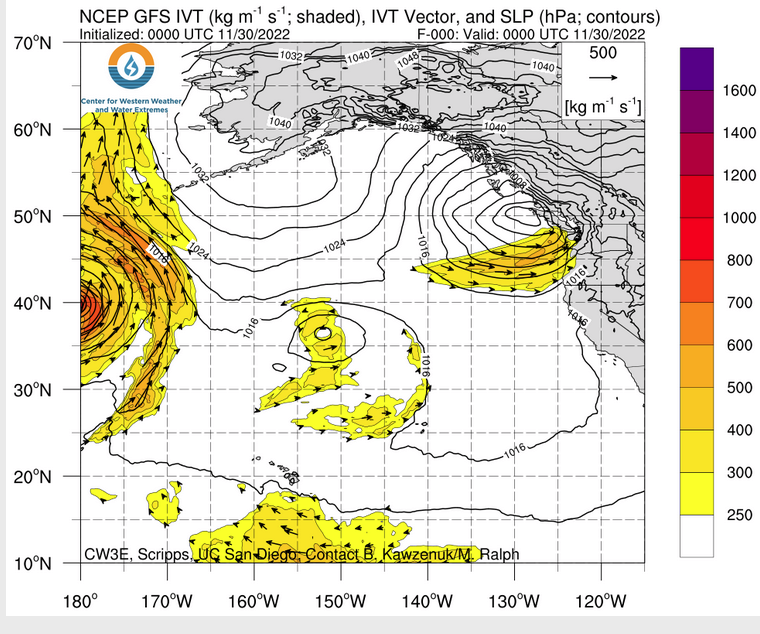 Click HERE to update. Here is some useful information about Atmospheric Rivers.
Click HERE to update. Here is some useful information about Atmospheric Rivers.
HAZARDS OUTLOOKS
Click here for the latest complete Day 3 -7 Hazards forecast which updates only on weekdays. Once a week probably Monday or Tuesday I will update the images. I provided the link for readers to get daily updates on weekdays. Use your own judgment to decide if you need to update these images.
Worldwide Tropical Forecast
(This graphic updates on Tuesdays) If it has not been updated, you can get the update by clicking here This is a new approach and covers weeks 2 and 3 not weeks 1 and 2. It has more information but I am having trouble getting used to it. As usual, it comes with a discussion which is below
Detailed Maps and Reports for the Western Atlantic and the Pacific Oceans
Below are four maps that summarize the situation for the Atlantic, Eastern, Central Pacific, and Western Pacific. Additional information can be accessed by clicking HERE
First the Atlantic
Click to view the forecast map and have access to additional information https://www.nhc .noaa.gov/gtwo.php?basin= atlc&fdays=5
Then Eastern Pacific
Click to view the forecast map and have access to additional information https://www.nhc.noaa.gov/gtwo.php?basin=epac&fdays=5
Then Central Pacific
Click to view the forecast map and have access to additional information https://www.nhc.noaa.gov/gtwo.php?basin=cpac&fdays=5
And the Western Pacific
Click to view the forecast map and have access to additional information https://www.metoc.navy.mil/jtwc/jtwc.html
Some Intermediate-Term Outlooks
Links to “Outlook” maps and discussions for three time periods. Days 6 – 10, Days 8 – 14, and Weeks 3 and 4. An outlook differs from a forecast based on how NOAA uses these terms in that an “outlook” presents information from deviation from normal and the likelihood of these deviations.
You have to click on the links because they do not update automatically and I do not want to have stale images in the article. But it is not difficult to click on a link and you get a large image plus a discussion. On Fridays in a separate article, we will show the images and provide a link in this article that article. But remember what you will see is the images as of Friday. But here you can get the current images simply by clicking on them. Then hit the return arrow at the upper left of your screen to return to the article. You will not find this information easily anywhere else.
| There was a drastic change in the forecast from Friday to Monday so you may want to click on the above links to see the current outlook. We show the maps in the weekend edition of our weather reporting. It is not possible at this time for us to provide all of the weather maps every day but we provide the links so readers can click on the links and view them. |
Worldwide Weather (The U.S. is part of the World so the U.S. forecast is included in these maps)
Below maps are the short-term forecast for precipitation and 10-day forecast for temperature and precipitation. I update them daily but if you are looking at an out-of-date version of this article the current forecast maps can be obtained HERE.
Month to Date Information
Month to date Temperature can be found at https://hprcc.unl.edu/products/maps/acis/MonthTDeptUS.png
Month to date Precipitation can be found at https://hprcc.unl.edu/products/maps/acis/MonthPNormUS.png

